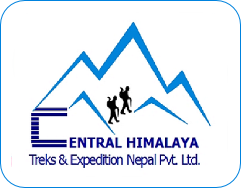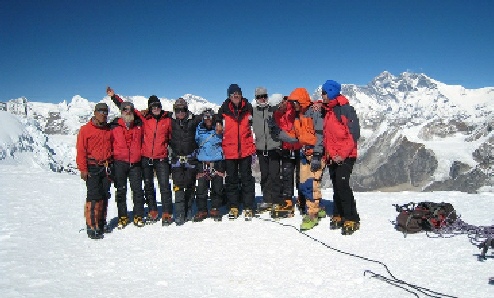

Day 1 . Arrival in Kathmandu transfer and reception at the hotel, welcome dinner evening with typical Nepalese dishes.
Day 2. Visit different places of the capital Kathmandu and preparation of official documents like the climbing permit.
Day 3. Transfer to airport for flight to Lukla 2800m, on arrival preparation for hiking the next day at the base camp. Overnight in Lukla.
Day 4. From the village of Lukla A rise in lush vegetation to reach Chutanga. (3173 meters), 6 hours walking
Day 5. Chhuthanga - Chhetarbu :
fairly hard climb throughout the day through a forest of pine and rhododendron short descent then about an hour to finish the day. 5 1/2 hours of walking.
Day 6. Chhetarbu - Kothe:
Descent mostly through a narrow valley to take advantage on the right, a beautiful view of Mera Peak. 5 hours of walking.
Day 7. Kothe - Thangnak Slight uphill along a small river by a narrow valley. 5 1/2 hours of walking.
Day 8. Thangnak - Khare (4355m)
Easy ascent along a small river with an interesting view of Mera Peak and summits. The walk continues up to Khare (4355 meters). 4 hours and a half walk.
Day 9. Khare: Rest day, though the walks are recommended around Khare for acclimatization.
Day 10. Khare - Mera camp base (4730m)
climb steeply for half an hour to an hour and then follows a route between the glacial moraine and tea to camp near glacier (4730 meters).. 4 to 4 1/2 hours of walking.
Day 11. Camp base Mera:
Rest day for acclimatization and to practice walking on the glacier. Preparation of equipment with useful cleats from this step.
Day 12. Mera Base Camp - Camp higher
Light mounted on the upper glacier to camp. It is essential to be well equipped, crampons, sticks etc. 3 1/2 hours of walking.
Day 13. Higher Camp - Mera Peak Summit - Khare
The real expedition starts early at 3 am for the ascent of Mera Peak. We will be roped up and well equipped to face ice and snow up to the summit where you can admire and admire an exceptional panorama of Mount Everest, Makalu, Baruntse, Lhotse and other peaks such as Mount Kanchanjanga 'East. After this contemplation they descend to Khare. 11 hours of walking.
Day 14. Khare - Kothe (4303m):
Descent by the same route as the up Kothe. (4303 meters). 6 1/2 hours walking.
Day 15. Kothe - Thuli kharkka (3173m)
Day which still requires effort as walking is often uphill. Arrival at Thuli Kharka (3173 meters). 6 1/2 hours walking.
Day 16. Thuli Kharka - Lukla. :
Two hours climb to Zatrwa La pass and then down to Lukla. 6 hours of walking.
Day 17 Lukla - Kathmandu:
Departure from Lukla towards Kathmandu with a morning flight.
Day 18. Visit the old districts of the capital,
Discovery of temples and sculptures, palaces, stupas, etc. Mingling also with the smiling, sympathetic and moving population in its religious practice. In the evening a dinner in the typical Nepalese restaurant will allow exchanges of impressions on this day.
Day 19. Departure and transfer to the international airport for your return.
Mera Peak 6654 m (Everest area)

Mera Peak is one of the highest and highest trekking peaks in Nepal. The trek begins by flying over the mountains in the heart of the Himalayas in the direction of the village of Lukla.
From there, you will enter the national park. Your mountain licenses will be checked as well as the compulsory registration of each trekking permit. To reach Mera to acclimatize you will have to walk in a remote valley and climb gradually towards the base camp to establish an altitude camp at the foot of the glacier from where you can reach the summit.
You will have excellent views of the Makalu, Everest, the Lhotse and other spectacular summits. It is a big trek with a steady climb on a land where graze the yaks that the Sherpas still raise. They cook on yak dung fires and their lifestyle is very simple. For your stay to be the most pleasant and culturally interesting, porters will accompany you carrying food, equipment and materials.
Un guide sherpa (Sirdar), l’équipe de cuisinier en charge de votre trek sont présents pour vous encourager à grimper. Nous passerons un moment important pour nous adapter aux nouvelles altitudes, pour accroître la sécurité et le confort et nous habituer également aux déplacements sur glacier. Pour cela il faut un certain temps qui est fonction de la forme de chacun pour l’acclimatation et l’assurance d’une bonne marche qui favoriseront ainsi la conquête du sommet.
By its standard route of the Fera La, the ascent is technically simple, but after a heavy snowfall or when the crevasses are open, the route can be modified, longer or even more painful. The most rewarding aspect of a trip to Mera is to venture into a region of Nepal that is still authentic and little visited. The hillsides are always wooded. In this region it is necessary and indispensable to be self-sufficient. Of course every trekker will have the satisfaction and pleasure to go above 6000 m.
There are several approaches for Mera, some are easy and some require the passage of high and difficult passes. Making a trek to the summit is a real mountaineering adventure for which the effort is rewarded with spectacular scenery offering the satisfaction of being one of the most beautiful views in Nepal. It is the perfect journey for the mountaineer who wants to enjoy his Himalayan adventure, living and enjoying a unique culture and climbing in the Alpine style, the traditional Himalayas.
A sherpa guide (Sirdar), the cook team in charge of your trek are present to encourage you to climb. We will spend an important time to adapt to new altitudes, to increase safety and comfort and to get used to glacier travel. For this it takes a certain time which depends on the shape of each one for the acclimatization and the assurance of a good walk which will thus promote the conquest of the summit.
Duration: 19 to 20 days - Difficulty: Sport +:
The difficulty of this climb is know walking on snow and adaptation to altitude. Technically there is not much risk, as the normal way of the Mont Blanc of Europe.
Equipements :
Piolet, baudrier, 4 mousquetons, jumar, ascendeur, descendeur, paire de guêtres, lunettes de glacier, broche à glace, chaussures coque, crampons, vêtement de haute montagne.








